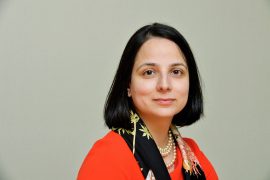Women in financial services: Bhavna Saraf of Lloyds Banking Group
FinTech Futures recently sat down for a fireside chat with Bhavna Saraf, managing director, product head of digital bank, commercial business transformation at Lloyds Banking Group.

Bhavna Saraf of Lloyds Banking Group
In a career spanning over two decades, Saraf has previously worked at a host of tier one banks including HSBC, Citi and Rabobank. Over the years, she has held various leadership roles around product, sales and business strategy.
“But one thing that has been constant across all the roles I have done is that I love building businesses – whether it is taking something from zero to one or just taking growth to the next level,” says Saraf.
A passion for all things tech
“I’ve got an obsession in terms of building frictionless outcomes for our customers,” Saraf says. “And I love technology as an enabler of all that. I find technology inspiring and humbling at the same time.”
Saraf habitually attends fintech events and conferences to scan the horizon for companies that have the technology to accelerate projects and look out for potential partnerships. Because of this, she clearly has her finger on the pulse of the fintech industry.
She believes these visits are important for two reasons.
“One, to see what problems we’re looking to solve for our customers and how we can accelerate some of the outcomes by partnering with companies who do this for their day job, rather than us trying to mimic a technology company,” she explains.
“Secondly, I have views, so this gives me an opportunity to validate or invalidate my own hypotheses around some topics and just verbalise some of those ideas.
“Sometimes you’ve got a head full of ideas, and unless you speak about them to people you don’t know whether it makes sense,” she says.
Risk, influence, resolve
Risk, influence and resolve. These three things are what Saraf believes have brought her this far in her career.
“Every time I did these three things, people around me started profiling me as somebody who could carry their weight in the organisation, deliver results and didn’t need to be babysat,” she says.
“It also gave me a chance to know a bit about myself and what I could do, because sometimes, especially for women, we get into a comfortable position, and then we don’t know how to get out from that comfort zone.”
Saraf has been working at Lloyds for the last four years covering trade and working capital, business transformation, payment partnerships and strategy for the financial services group.
Talking about her current role, she says: “If you think about organisations, they can be very fragmented, very disparate, siloed.”
With different businesses of the group pursuing different strategies, Saraf says her role is to “lift some of these siloed conversations and bring them at an enterprise level to say what are the battles we want to win and where is the runway to be had”.
For a commercial bank with a market share of approximately one-in-five businesses, being able to service a diverse demographic of business customers is an obvious and necessary requirement – from start-ups to growing SMEs, all the way to mid-corporate companies and large, global corporates and financial institutions.
“The experience in the personalisation associated is going to be very different, the channels are going to be different.
“So, what are the participation choices you want to make that will continue to deliver returns for the investors, and create more enduring relationships for customers? I help build that strategy working with business.”
Trends in payments
The acceleration in the use of online payment channels is no secret, with the digital wallet economy showing increased uptake.
Saraf believes that layering interoperability with distributed ledger technology (DLT) and tokenisation has the potential to “transform” and build ecosystems, citing Chinese mobile app WeChat as an example of building out new verticals.
“It just started off as a messaging platform, and now any average person in China starts their day with WeChat – whether it is hailing a cab, ordering a takeaway, making a payment, making an investment choice or making a purchase.
“So, how do you create ecosystems of adjacencies for the clients, so that even though they come to the bank for making a payment, they get hooked into the ecosystem and we can service a lot of other adjacencies?
“The idea is to keep them in that ecosystem and address some of their needs around that,” Saraf says.
What excites her most, though, is the notion of meeting customers where they want to be met, at the time and in the manner that they want to be met, instead of expecting them to come to physical banks.
“How can we embed banking services in social media, as an example? If you ask me what’s the connection between payments and digital identity, I say, well, that’s the starting point,” she says.
“You want to know who’s making the payment, where that payment is going.
“Payment is the last mile of every transaction, but it’s such an interconnected world. Artificial intelligence (AI), the Internet of Things (IoT) and 5G will drive further innovation and improve the way we live and work. I’m excited about how this space is going to evolve.”
All-encompassing focus
When asked about the group’s future plans as we enter 2023, Saraf says Lloyds will continue to leverage its brand value, stable financial profile and customer base of over 30 million to be the “best in class” for its customers.
“We don’t have the luxury of saying we want to only cater to one type of segment. As a bank with 250 years plus of history, we are the national champion, we are that high street bank,” Saraf concludes.











































